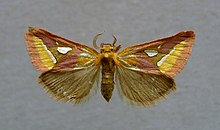| Axia | |
|---|---|

| |
| Axia margarita | |
| Scientific classification | |
| Domain: | Eukaryota |
| Kingdom: | Animalia |
| Phylum: | Arthropoda |
| Class: | Insecta |
| Order: | Lepidoptera |
| Family: | Cimeliidae |
| Genus: | Axia Hübner, 1821 |
| Synonyms | |
| |
Axia, the gold moths, is a genus of moths whose precise relationships within the macrolepidoptera are currently uncertain, but they currently are placed within the superfamily Drepanoidea. Uniquely, they have a pair of pocket-like organs on the seventh abdominal spiracle of the adult moth[1] which are possibly sound receptive organs.[2] They are quite large and brightly coloured moths that occur only in southern Europe and feed on species of Euphorbia. Sometimes they are attracted to light.[1] The genus was first described by Jacob Hübner in 1821.
One species, Epicimelia theresiae, was formerly included in this genus, but has since been recognized as distinct; it represents the only other described genus in the family.[3]
- ^ a b J. Minet (1999). "The Axioidea and Calliduloidea". In N. P. Kristensen (ed.). Lepidoptera, Moths and Butterflies. Volume 1: Evolution, Systematics, and Biogeography. Handbuch der Zoologie. Eine Naturgeschichte der Stämme des Tierreiches. Walter de Gruyter, Berlin & New York. pp. 257–261.
- ^ J. Minet & A. Surlykke (2003). "Auditory and sound producing organs". In N. P. Kristensen (ed.). Lepidoptera, Moths and Butterflies. Volume 2: Morphology and Physiology. Handbuch der Zoologie. Eine Naturgeschichte der Stämme des Tierreiches. Walter de Gruyter, Berlin. pp. 289–323.
- ^ [1] Shen-Horn Yen and Joël Minet (2007) Cimelioidea: A New Superfamily Name for the Gold Moths (Lepidoptera: Glossata). Zoological Studies 46(3): 262-271